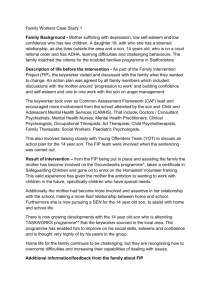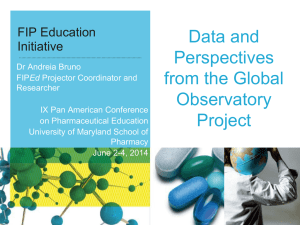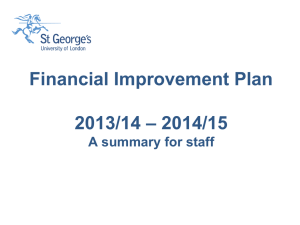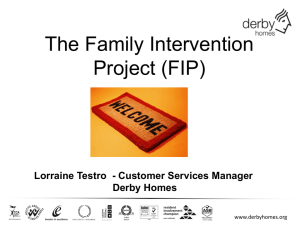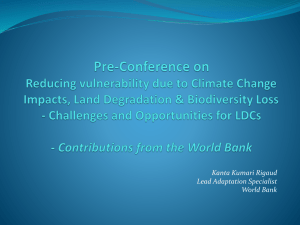Honduras FIP and PPCR Scoping Mission -Aide-Memoire
advertisement
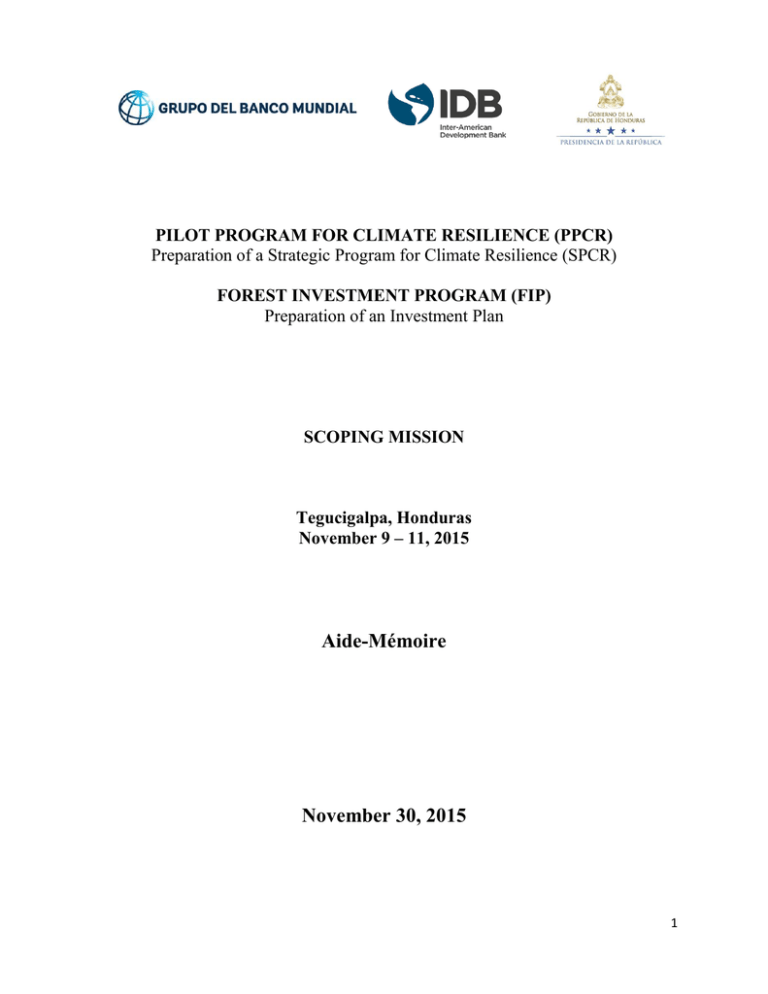
PILOT PROGRAM FOR CLIMATE RESILIENCE (PPCR) Preparation of a Strategic Program for Climate Resilience (SPCR) FOREST INVESTMENT PROGRAM (FIP) Preparation of an Investment Plan SCOPING MISSION Tegucigalpa, Honduras November 9 – 11, 2015 Aide-Mémoire November 30, 2015 1 I. INTRODUCTION 1. A scoping mission for the Pilot Program for Climate Resilience (PPCR) and Forest Investment Program (FIP) involving the Government of Honduras (GOH), the Multilateral Development Banks (International Bank for Reconstruction and Development (IBRD) and Inter-American Development Bank (IADB)) and their partners was held in Tegucigalpa from November 9-11, 2015. The World Bank team included Christian Peter (Program Leader for Sustainable Development, Central America, and Task Team Leader, FIP), Ana Campos Garcia (Senior Disaster Risk Management Specialist, and Task Team Leader, PPCR), Lizardo Narváez (Disaster Risk Management Specialist), Nancy Chaarani Meza (Operations Officer), Gabriela Encalada Romero (Environmental Specialist), and Kazi Fateha Ahmed (Team Coordinator for PPCR) on behalf of the World Bank. The Inter-American Development Bank (IDB) team included Omar Samayoa (Climate Change Specialist) and Ana Saori Iju Fukushima (Climate Change Specialist). 2. The mission had the following objectives: (i) provide an informative, detailed summary on the PPCR and FIP Programs to the institutional representatives prioritized by the Government, especially on the requirements, next steps, and commitments; (ii) present the political and strategic vision of the country on climate change, including climate change plans, national development strategies, as well as REDD and REDD + strategies; (iii) based on the Expression of Interest (EOI) of both Programs, analyze the knowledge gaps on the issues prioritized by the Government (critical sectors) in order to identify technical studies necessary to assess the feasibility of the projects to be integrated in the PPCR and FIP; (iv) prepare a first outline of the work plan for each program, defining the scope, activities, timelines, and responsible parties; (v) define the coordination mechanisms and the initial institutional arrangements required for the management of PPCR and FIP processes; (vi) define and prioritize the consultation mechanisms with development partners, non-governmental organizations, donors, and other actors involved, as required by the PPCR and FIP processes; and (vii) define a preliminary budget of the funds needed for PPCR and FIP preparation based on the CIF templates. 3. The scoping mission for the PPCR and FIP Programs was attended by 71 delegates from 22 institutions, including the Ministry of Energy, Natural Resources, Environment, and Mining (MiAmbiente), the Ministry of Finance (MOF), the Ministry of Infrastructure and Utilities (INSEP), the Ministry of Agriculture and Livestock (SAG), the Disaster Risk Management Agency (COPECO), the National Autonomous Service of Aqueducts and Sewers (SANAA), and the Institute of Forest Conservation (ICF), among others. The full list of participants can be found in Annex 1. 4. Both teams from the World Bank and the IDB are grateful to the authorities of the GOH for organizing the visit, for coordination meetings, and for the support and care provided on the various topics discussed during the mission. 5. This aide-mémoire summarizes the results, recommendations, and agreements reached during the mission for the PPCR and FIP processes, and will be publicly disclosed by the Administrative Unit of the Climate Investment Funds (CIF). II. CONTEXT (ON PPCR AND FIP) General objectives of PPCR 6. The overall objective of the Pilot Program for Climate Resilience (PPCR) is to assist developing countries to integrate climate resilience into development planning, consistent with the objectives of 2 promoting a sustainable development and reducing poverty. The PPCR supports hands-on learning and innovative solutions to pressing climate-related risks. 7. The PPCR promotes a participatory approach towards the development of a medium to long term climate change adaptation strategy at the national level. This process requires the participation of a wide range of stakeholders: the different sectoral line ministries, national/local government agencies, academia, private sector, NGOs, civil society organizations (CSOs), among others. The goal of the PPCR is to achieve a balanced effort between development partners in order to effectively cooperate, engage in dialogue, and adopt this strategic approach as a common platform. 8. In this context, Honduras was selected by the PPCR Sub-Committee as one of ten beneficiary countries of the Program, joining 18 countries around the world already involved in this initiative. This scoping mission initiates support to the Government of Honduras to launch the process for the development of the Investment Plan (IP) under the Forest Investment Program (FIP) and for the Strategic Program for Climate Resilience (SPCR) under the Pilot Program for Climate Resilience (PPCR). General objectives of FIP 9. The FIP seeks to pursue policies, actions, and the mobilization of resources tosupport developing country efforts to reduce emissions from deforestation and forest degradation and promote sustainable forest management and enhancement of forest carbon stocks. The program itself would not provide the incentives needed today to significantly reduce the emissions of greenhouse gases derived from forests, but would allow pilot countries to multiply these incentives if established through a forest mechanism under the United Nations Framework Convention on Climate Change (UNFCCC). 10. In this regard, Honduras has been selected by the FIP Sub-Committee as one of nine countries to develop the Investment Plan (IP), with resources from CIF, through Multilateral Development Banks (MDBs). III. DEVELOPMENT OF THE MISSION AND MAIN RESULTS 11. Considering that both the PPCR and FIP seek complementary objectives and respond to the same logic of intervention regarding adaptation and mitigation schemes, it is considered appropriate to analyze the scope and results of the mission together in order to achieve synergy and efficiency in the implementation of both processes. Development of the Mission and Consultations with Key Government Actors to develop the PPCR y FIP processes 12. The scoping mission began with opening remarks by the Ministry of Energy, Natural Resources, Environment, and Mining (MiAmbiente), Mr. Jose Antonio Galdames, and by representatives of the IDB (Mirna Liévano Marques) and the World Bank (Martin Ochoa). 13. Mr. Galdames thanked the banks for their support in climate change adaptation and mitigation measures. Mr. Galdames emphasized noting that Honduras is considered the country most affected by extreme weather events and has been recently ranked as the country most vulnerable to climate change worldwide. He urged participants to work together towards the identification of alternatives that contribute to the consolidation of the 2014-2018 National Development Plan: “Plan de Todos 3 para una Vida Mejor” which includes climate resilience as a crosscutting issue in the country’s development. 14. Following Mr. Galdames remarks, Mr. Luis Rivas, the alternate focal point designated by the Government of Honduras for the PPCR and FIP Programs, made a general presentation on the background, scope, schedule, and expected results of the mission. This presentation is included in Annex 2. 15. The introduction session concluded with two presentations by the MDBs on specific information regarding each Program, including the source of financing and investment plans that are expected to be formulated in Honduras. Annexes 3 and 4 include the presentations on the PPCR and FIP Programs. 16. Five presentations were given by sector line ministries during the mission. Presentations were prepared in advance by technical staff of the relevant institutions using a set of guiding questions. The main topics for each presentation were: - Legal and institutional framework and coordination mechanisms Gaps and challenges to clarify the regulatory, institutional, and/or coordination frameworks Processes and current investments Strategic investments of a transformative nature that should be prioritized Gaps in knowledge / information to implement these investment / transformative strategies Institutional arrangements that should be established or activated to strengthen coordination between institutions and to improve institutions 17. The following table summarizes the basic information on the five presentations, which are included as Annexes 5-9. Theme Prepared By Presenter Climate change and risk management MiAmbiente (DNCC) Sergio Palacios, National Director of Climate Change Knowledge of climate risks COPECO Francisco J. Argeñal, Deputy Chief CENAOS - COPECO Agriculture and food security SAG Ricardo Peña. Director, Planning Unit SAG Water resource management MiAmbiente (DGRH), SANAA, FHIS, CONASA Fernando Ochoa, Technical Assistant, General Directorate of Water Resource Management (MiAmbiente) Forest Development ICF Miguel Mendieta, Chief Planning Unit. Forest Conservation Institute 18. The presentations helped to clarify the legal and institutional frameworks governing the different themes under consideration for the PPCR and FIP programs. The presentations also illustrated the processes in place, current investments as well as an updated map of stakeholders. This information served as useful input for subsequent working group sessions. 4 19. After the sectoral presentations, a first group exercise was conducted to identify key actors that should be integrated into the PPCR and FIP consultation processes. Annex 10 includes a table with the results of this exercise. Priorities identified by government entities to develop the SPCR (PPCR) and the Investment Plan (FIP) o PPCR: 20. A collective exercise was conducted to identify relevant themes of the PPCR program within the framework of eligible costs under the grants in the short term. The actions to be included in the request for resources will cover the following five categories: a. b. c. d. e. Analysis of climate risks in order to inform policies and programs (short-term studies) Design of policy reforms and institutional strengthening Capacity building activities, consultation processes, and national awareness exercises Definition of priority actions, including investments for the SPCR project portfolio Technical, administrative, and financial management of the project 21. The preliminary results of the above mentioned exercise identifying priority actions organized by eligible category under the Technical Assistance Grant are found in Annex 11. It is expected that these inputs will serve the GOH when defining the activities to be financed with donations and guide the development of the SPCR. 22. As a result of this exercise, a number of opportunities and challenges for the PPCR process in Honduras were identified: a. Opportunities The PPCR process represents an opportunity to activate and strengthen the various existing committees and subcommittees related to climate change, food security, water resources, disaster risk management, and adaptation to climate change. Particularly, it is expected that the program will contribute to consolidate the Inter-Agency Committee on Climate Change’s work, created by the Climate Change Law, in effect since November 2014. Another related opportunity is the modernization and regulation of some key legislation in the country, such as the Climate Change Law. The PPCR also provides an opportunity to have a strategic policy framework that is expected to strengthen the ““National Climate Change Strategy” (NCCS 2010-2038)” and the National Adaptation Plan, the latter currently being formulated. Regarding international cooperation, a roundtable of donors is currently working around climate change and risk management issues. This provides an opportunity for the PPCR process not only to channel and guide the actions of the participant MDBs, but of a larger group of cooperating agencies as well. 5 b. Challenges The existence of the various levels of interagency coordination mechanisms can limit the timeliness of the consultation, review, and approval processes during the formulation of SPCR. Instruments to manage climate change adaptation and mitigation are under development, for example, the Climate Change Law has not yet been regulated. ), This may hamper the inter-institutional work since the absence of specific mandates may lead to the duplication of efforts in climate change activities. 23. In the context of the challenges identified for the PPCR, it was clarified that interagency coordination is critical to building climate resilience both at the national and local level. On the other hand, it was mentioned that, as part of the technical assistance for the preparation of the SPCR, activities towards institutional strengthening could be financed, even if their implementation extend beyond the presentation of the SPCR. o FIP 24. The GOH presented the political and strategic vision of the country on climate change, including climate change plans, national development strategies, as well as REDD , and REDD + strategies Also, a summary of ongoing activities related to the forestry sector and climate change was presented. These activities will serve as inputs when identifying priorities, needs, and gaps requiring analysis for the preparation of the Investment Plan. 25. As a starting point, the Expression of Interest sent by the Government of Honduras was reviewed. The EOI includes a proposal of possible approaches for the development of the Investment Plan. Based on these inputs, the discussion focused on how to align the proposal with potential areas of investment and with FIP objectives: (i) initiate and pave the way for the transformation of the forest policies and practices; (ii) implement replicable pilot models to generate an understanding of the relationship between sustainable forest management, policy measures to reduce GHG emissions, and long-term conservation measures; (iii) facilitate the leveraging of additional financial resources for REDD; (iv) provide valuable experience and feedback in the context of UNFCCC deliberations. 26. As a result of this exercise, a matrix showing the results of this first brainstorming session was prepared, which should be revisited again when drafting the Investment Plan (see Annex 12). 27. The format of the Forest Investment Plan was reviewed and responsibilities and deadlines were defined to address the different requirements. (See the section on next steps). 28. Given the multisectoral nature of the PPCR and FIP, the mission identified an overlap in mandates, policies, and investment strategies, which require further analysis in the preparation and implementation frameworks of both programs. IV. COORDINATION MECHANISMS FOR PPCR AND FIP Coordination mechanisms for the PPCR and FIP at the political level 29. The political leadership of the PPCR and FIP Programs is assumed by the Minister of Economic Development, Mr. Alden Rivera, who coordinates the portfolios of Environment, Agriculture, Social 6 Security, Tourism, and the Forest Conservation Institute, among others. During the mission, the importance of a high-level political commitment to facilitate the coordination of the PPCR and FIP processes in Honduras was emphasized. It was also agreed that a meeting with the objective to create the Inter-Agency Coordination Committee for both programs would be scheduled. This meeting, originally planned for Monday, November 9, 2015, did not take place. 30. The GOH confirmed MiAmbiente as the lead institution of both PPCR and FIP Programs. Specifically, the Deputy Minister of Energy, Mr. Elvis Rodas, acts at the management level, with Mr. Luis Alfredo Rivas acting as an alternate delegate. 31. During the mission, it was acknowledged that a Memorandum of Understanding between the Ministry of Finance and MiAmbiente exists for the purpose of – among others – coordinating the management of financial resources for climate change issues. In this context, the SPCR process will enable actions related to strategic planning, formulation of project portfolio, and institutional strengthening which will contribute to the process towards accreditation of the country by entities such as the Green Climate Fund, among others. Coordination of the PPCR and FIP at the technical level PPCR 32. During the mission an analysis of four, formally-established, inter-institutional bodies was conducted. Each committee was analyzed based on five dimensions: (i) is it active?, (ii) does it integrate all actors relevant to the PPCR?, (iii) is it part of the government's agenda?, (iv) does it address all PPCR themes?, and (v) is it functional? The results of this exercise are presented in Annex 13. 33. As a preliminary result, participants in the mission concluded that the Inter-Agency Technical Committee on Climate Change (CTICC) would be most appropriate consultative body for coordination purposes of the PPCR at the technical level. However, it was also agreed that the number of participants attending meetings of the advisory committee should not be too high, since any analytical work would not be practical a large number of participants. It was then concluded that a group of delegates, acting as a "sub-committee" within the CTICC, would be the best alternative for the PPCR. 34. Also, the CTICC is considered as the appropriate consultative body which may allow technical coordination of PPCR issues with other resilience or adaptation initiatives or projects currently underway in Honduras. This would strengthen the technical level coordination capacity and synergy that the PPCR should have with other existing initiatives. FIP 35. MiAmbiente pledged to assign a full-time coordinator throughout the process of preparing the Investment Plan. For the early stages of preparation of the IP, and in order to provide additional support, the World Bank proposes to use its own funds to hire a consultant. 36. To ensure the proper development of the FIP processes, it will be critical to have the active participation of an interagency technical group (SAG, ICF, MiAmbiente, among others), which should be officially appointed by the respective, competent authorities. 7 V. ARRANGEMENTS AND EXECUTION OF THE PPCR AND FIP PROGRAMS (PROGRAM IMPLEMENTATION ARRANGEMENTS) 37. As part of the PPCR and FIP programs, Honduras can access technical assistance grants of up to $1.5 million and $250,000, respectively. These funds are intended to facilitate the processes of preparing the SPCR and FIP Investment Plan, including costs for technical studies required for the development of investment plans, participatory consultation processes with stakeholders, and raising awareness about change climate, among others. The MDBs shared the application forms for these funds with the country’s focal points for PPCR and FIP programs and explained the processes and deadlines for completion of these financing proposals. It was agreed that the MDBs and MiAmbiente will continue to prepare these funding proposals for preparation funds for the PPCR and FIP, based on the priorities identified during the mission. The estimated completion schedule of these proposals, review by the MDBs and approval by the PPCR and FIP, is in the next section of this aide-mémoire. 38. During the mission it was also confirmed that preparation funds for both the PPCR and FIP would be executed by the Government of Honduras through the World Bank, which will allow for greater coordination at the technical level, as well as for greater efficiency at the administrative level given economies of scale. Alternatives are under consideration regarding the implementing agency for these funds, including MiAmbiente’s Project Coordinator Office (PCO) or Invest-H. The World Bank has done a fiduciary assessment of the PCO and will communicate the results of the evaluation to MiAmbiente for their consideration. The evaluation includes a number of recommendations that should be adopted so that the PCO can run funds. 39. As Invest-H already executes World Bank funds, it has extensive experience that can be helpful to the PPCR and FIP processes. In this sense, especially considering the timeline for implementation of both Programs and that the recommendations for the PCO could take time to be implemented, it is considered a more appropriate option for MiAmbiente to carry out the technical coordination while Invest-H assumes the fiduciary responsibility and implementation of the funds. This would facilitate the implementation of resources while also strengthening MiAmbiente’s capacity for the future. During the mission, both the MDBs and MiAmbiente reiterated the need to define the arrangements for implementing the funds as soon as possible so as to avoid delays in the PPCR and FIP processes. VI. NEXT STEPS AGREED UPON DURING THE MISSION AND RESPONSIBLE PARTIES 40. The table below summarizes the agreed upon next steps and responsible parties for the PPCR and FIP processes. It was also agreed that the PPCR and FIP processes will work in parallel as possible, and that synergies will be sought in the preparation of the PPCR and FIP Investment Plans. 8 Table of activities, responsible parties, y dates Activity Responsible Party Date Approve the aide-mémoire of the Scoping Mission and the work plan for the PPCR GOH End of November 2015 Continue to identify priorities for the preparation funds GOH with MDB support End of November 2015 GOH December 2015 PPCR Confirm coordination arrangements at both high level and technical level Finalize funding proposals for PPCR preparation (phase 1), including implementation arrangements Review of funding proposals for PPCR preparation by MDBs Send final funding proposals for PPCR preparation to the CIF approval sub-committee Prepare detailed plans for activities and acquisitions for review by MDB teams Prepare the TOR for the First Joint Mission and send to the PPCR sub-committee for comments Sign the PPCR Donation Agreement (tentative) Invite participants to the First Joint Mission First Joint Mission Prepare the SPCR – technical studies, consultations, and national awareness Prepare the TOR for the Second Joint Mission and send to the PPCR sub-committee for comments Finalize the first draft of the SPCR and share with MDBs for review/comments Second Joint Mission Review the SPCR after the Second Joint Mission Approval of the SPCR on behalf of the PPCR Inter-institutional Coordination Committee (high level) Send the final version of the SPCR to the PPCR sub-committee Present the SPCR to the PPCR sub-committee GOH with MDB support WB and IDB Mid-December 2015 Mid-to-late-December 2015 GOH Early-January 2016 GOH January 2016 GOH with MDB support WB – GOH GOH GOH and MDB GOH with MDB support GOH with MDB support GOH with MDB support GOH with MDB support GOH with MDB and independent expert support Early-February 2016 Early-March 2016 Early-March 2016 Mid-March 2016 March-June 2016 Mid-May 2016 Mid-June 2016 Late-July 2016 August 2016 GOH Mid-September 2016 GOH GOH Late-September 2016 November 2016 GOH with MDB support Late-December 2015 WB and IDB Mid-January 2016 GOH Late-January 2016 GOH Late-January 2016 FIP Finalize the profile proposal for the FIP preparation funds, including implementation arrangements Review of the profile proposal for the FIP preparation funds by the MDBs Send the final proposal for the FIP preparation funds to the CIF sub-committee for approval Prepare detailed plans for activities and acquisitions for review by MDB teams Prepare the TOR for the First Joint Mission and send to the FIP sub-committee for comments Sign the FIP Donation Agreement (tentative) First outline for the Investment Plan in appropriate FIP format GOH with MDB support World Bank – GOH GOH Early-February 2016 Early-March 2016 Late-February 2016 9 Tegucigalpa, December 2, 2015 Mr. José Antonio Galdames Minister of State of Energy, Natural Resources, Environment and Mining (MiAmbiente) Honduras Mr. Elvis Rodas Deputy Minister of State of Energy, Natural Resources, Environment and Mining (MiAmbiente) Honduras Christian Peter Program Leader, Sustainable Development Central America World Bank Ana Campos Garcia Senior Disaster Risk Management Specialist World Bank Omar Samayoa Senior Climate Change Specialist IDB Ana Saori Iju Fukushima Climate Change Consultant IDB Annexes: Annex 1. List of mission participants Annex 2. Presentation on the background, scope, schedule, and results Annex 3. World Bank presentation on the PPCR Annex 4. World Bank presentation on the FIP Annex 5: Presentation on climate change and risk management Annex 6: Presentation on climate risks Annex 7: Presentation on agriculture and food security Annex 8: Presentation on water resource management, water and sanitation Annex 9: Presentation on forest management Annex 10: Results: exercise on key actors and work groups for PPCR y FIP Annex 11: Results: exercise to identify actions (PPCR). Annex 12: Results: exercise to identify actions (FIP). Annex 13: Results: exercise analyzing the existing committees (PPCR) Annex 14: Links between PPCR/FIP and climate change 10
